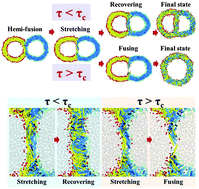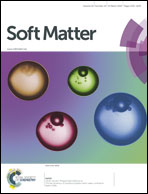The fusion mechanism of small polymersomes formed by rod–coil diblock copolymers†
Abstract
The fusion mechanism of polymersomes self-assembled by rod–coil copolymers is intrinsically different from that of liposomes due to the effect of chain topology on conformational entropy and molecular packing. The influences of membrane tension, coil-block length, rod-block length, mutual compatibility between the solvent and the rod–coil block, and π–π interaction strength on the fusion pathway are explored by dissipative particle dynamics. The fusion process of spontaneously formed polymersomes generally consists of four stages. In the kissing stage, hopping of rod-blocks forms a connection between two vesicles of a one-legged rod–coil copolymer. In the adhesion stage, a stalk is developed by a few link-up rods and then a stretched diaphragm with rods lying parallel to the stretching direction is formed in the hemi-fusion stage. Eventually, a pore is developed and expanded in the fusion stage. If the membrane tension (τ) is adjusted by deflation/inflation of the polymersomes, the hemi-fusion diaphragm disappears. As τ is reduced, multiple stalks take shape and lead to the formation of inverted micelles, which is the rate-determining step and raises the fusion time substantially. As τ is elevated, a neck is developed after the stalk formation. The fusion process is significantly accelerated. τ of spontaneously formed vesicles varies with the coil-block length, rod-block length, solvent quality, and π–π interaction strength. There exists a critical value of τ below which the fusion process cannot be completed and a hemi-fused polymersome is formed. In addition to τ, the anisotropic steric interactions within the rod layers also resist hopping of longer rod-blocks. The coil layers develop a barrier impeding fusion between vesicles with longer coil-blocks. Consequently, lowering the solvent quality for the coil-block or rod-block facilities the fusion process due to the formation of a thinner coil layer.


 Please wait while we load your content...
Please wait while we load your content...